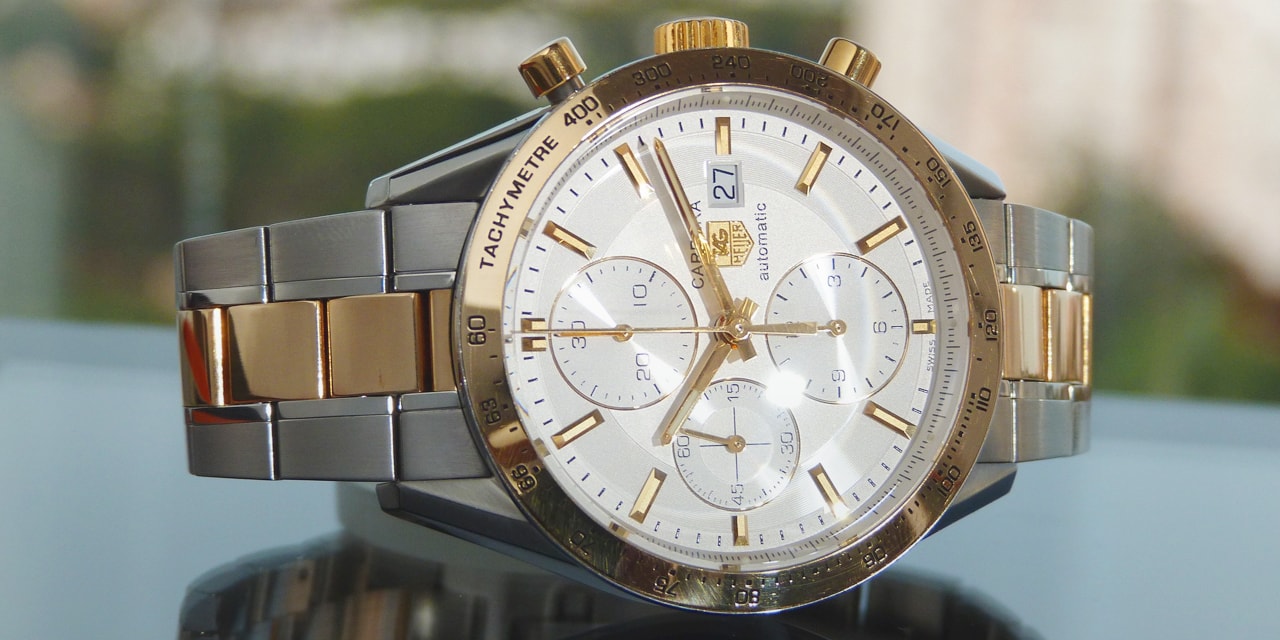The TAG Heuer Carrera
The world’s of luxury watch manufacturing and professional motorsport have long been intertwined. In fact, there are huge numbers of timepieces out there which have been inspired by and even named after either the competing vehicles themselves, or some of the events in which they race.
So we have Breitling for Bentley, Chopard’s Mille Miglia and, of course, the Rolex Daytona among hundreds of others.
But perhaps more than any brand, it is TAG Heuer which has most embraced the race track. Recently, we’ve seen them team up with F1 heavyweights such as Ayrton Senna and Michael Schumacher to create special edition pieces. But when you think of the real association between watchmaker and auto racing, it’s the vintage classics of the Monza, the Monaco and the Carrera which spring most readily to mind.
All three stemmed from the 1960s and ‘70s, back when TAG Heuer was just Heuer, and they all continued on well into the 21st century. However, the Monza has now been discontinued to allow more emphasis to fall on the Monaco and Carrera—the undoubted heavyweights not just of TAG’s portfolio, but of the racing watch genre in general.
Each has a very distinct personality. The Monaco is the unorthodox disruptive influence, the first square-cased waterproof automatic watch ever made. But it was the Carrera which came first, a suave thoroughbred of a timepiece, albeit one which took its name from perhaps the most murderous car rally ever run.
Below, we explore the history and legacy of Heuer’s iconic chronograph.
The TAG Heuer Carrera: History
Heuer had already established a rock-solid legacy for industry-leading chronographs by the time the first Carrera was created.
As far back as 1882, just 20-years into their history, they created their first chrono pocket watch, following that up in 1887 with the invention of the oscillating pinion, a key component in mechanical stopwatches still used by many top manufacturers today.
After the turn of the century, Heuer doubled down on their commitment to precise sports timings in 1911with the world’s first dashboard chronograph, the Time of Trip, their first chrono wristwatch in 1914 and the groundbreaking Mikrograph in 1916, the first chronograph able to measure down to 1/100thsecond.
Their commitment saw Heuer appointed as official timekeepers of the Olympic Games throughout the 1920s.
The legendary horologist, Jack Heuer took over the reins in 1958, the fourth generation of his family to run the company, and it was he who can take the most plaudits for reinforcing the brand’s reputation when it comes to motorsport. His debut creation revived the Autavia name for a new wristwatch in 1962, but his biggest success to date came the following year.
Inspired by stories of a tortuous border-to-border road race which took place in Mexico for just five consecutive years from 1950 to 1954, he decided he wanted a pure drivers’ watch, with simplicity, legibility and functionality uppermost in its design. So while the Carrera Panamericana was considered the most dangerous race, of any type, in the world, the Heuer Carrera chronograph became a watch strictly for the gentleman racer.
The First Carrera
The first reference, the ref. 2447, took to the stage in 1963 (interestingly, just across the border from Heuer’s base in Switzerland, German car giant Porsche were unveiling the inaugural 911 at almost exactly the same time, another entity which would become synonymous with the name Carrera. In 2021, the two brands teamed up to bring us the TAG Heuer Carrera Porsche Chronograph. But I digress).
The initial references of the 2447 featured a steel, 36mm round case, with sharply bisected lugs and pie pan dial. Hour markers were simple applied batons, raised from the surface, and the chrono counters were slightly recessed.
However, this first generation, in production from 1963 to 1970, went on to be issued in a number of different guises.
Where the earliest had single tone dials (usually silver) they soon graduated to Panda and reversed Panda forms for extra readability. Similarly, the watch could be had with two sub dials (the Carrera 45 and 30, with either a 45 or 30-minute totalizer) or three sub dials (the Carrera 12, which added a 12-hour register). There was also the Carrera 12 and Carrera 45 Dato, the first run of which had a date window at the 12 o’clock while later models located the display at the nine o’clock, sacrificing one of the sub dials leaving the watch as a mono-register.
As for the all-important movements, Heuer elected for the era’s best; the Valjoux 72 for the Carrera 12s, the Valjoux 92 for the 45s, and the Valjoux 7730 for the 30s. As for the Datos, they were powered by either the Valjoux 723 or the Landeron 189. All, at this time, were manually-winding.
While each of the variations shared the same case style, as the model progressed Heuer introduced 20-micron gold plated as well as full 18 karat examples.
But, as handsome and stylish as the watches were, the brand never lost focus on their occupation. The crown and push pieces were conspicuously large for the time, all the better to operate on the fly, and the chrono scales—either a tachymeter, pulsometer or decimeter—had their divisions marked on the outer crystal ring. So the watch could do without a numeral emblazoned bezel, leaving it more dressy and less casual, while at the same time opening up plenty more dial space to improve legibility.
The Carrera Through the Ages
By 1969, the race to build the world’s first automatic chronograph caliber had ended in a three-way tie, with Heuer’s contribution, the Calibre 11, arriving via the Chronomatic Group. This was a consortium of manufacturers joining together to share both manufacturing expertise and the huge costs involved, and was made up of Heuer themselves, along with Breitling, Buren and Dubois-Dépraz.
The Calibre 11 found homes in a range of Autavia models and the newly created Monaco, and kicked off something of a mini golden age for the Carrera.
Throughout the following decade, the brand released dozens of variations on the watch, with little to no resemblance with the original. The drift towards bigger, bolder models saw the Carrera adopt characteristically ‘70s barrel-shaped styling, together with far more in-your-face dial coloring. Jack Heuer’s fascination with speed also saw his company heavily sponsor Formula 1, collaborate with the Ferrari team and promote many of the period’s top drivers.
Sadly, it wasn’t to last.
The Heuer Carrera and the Quartz Crisis
As popular as the Carrera, and Heuer, were, they were no match for the massive influx of cheap, disposable and hugely accurate quartz watches flooding in from Japan and the U.S.
By the end of the 1970s, the manufacturer was in real financial trouble—so much so, in fact, that by 1982 Jack Heuer had run out of options and was forced to sell the company and step down. Two years later, production of the Carrera ceased completely.
The story doesn’t end there, however. Saudi business group, Techniques d’Avant Garde bought out the concern in 1985, the business becoming the TAG Heuer we now know. They continued the association with motor racing, embracing rather than fighting against the latest technology by releasing the Formula 1 series of quartz models, as well as backing the McLaren Formula 1 team and linking with legendary racer Ayrton Senna for their famous ‘Don’t Crack Under Pressure’ marketing campaign.
The rekindled interest in the brand prompted the welcome return of the Carrera in 1996. Its first iterations were near copies of the historic original, the ref. 2447, with its sharp lugs, clean dials and sophisticated bearing.
After getting taken over again in 1996, this time by the enormous LVMH conglomerate, the company was given the safest pair of hands possible with the reinstatement of Jack Heuer as honorary chairman.
Today, the Carrera remains the flagship offering and exists in several different forms.
The name can be found on a number of non-chronograph day-date dress pieces, a range of vintage-inspired throwbacks, as well as a series of pure racer’s models, complete with tachy bezels and even some top-of-the-line tourbillon examples. Interspersed in amongst those, you will also see several ladies and quartz models with smatterings of gemstones.
Many of the contemporary Carrera models are powered by in-house movements, including TAG Heuer’s superb Calibre 02, with its column wheel, vertical clutch and incredible 80-hour power reserve.
All in all, the TAG Heuer Carrera still stands as one of the most important sports watches of all time, mentioned in the same breath as the likes of the Daytona, the Speedmaster and even its own stable mate, the Monaco.
From the brand which virtually invented the modern chronograph watch, it remains one of the very best.
— Featured Photo: Maurício Souza Mau from Pixabay Archive (cc).






